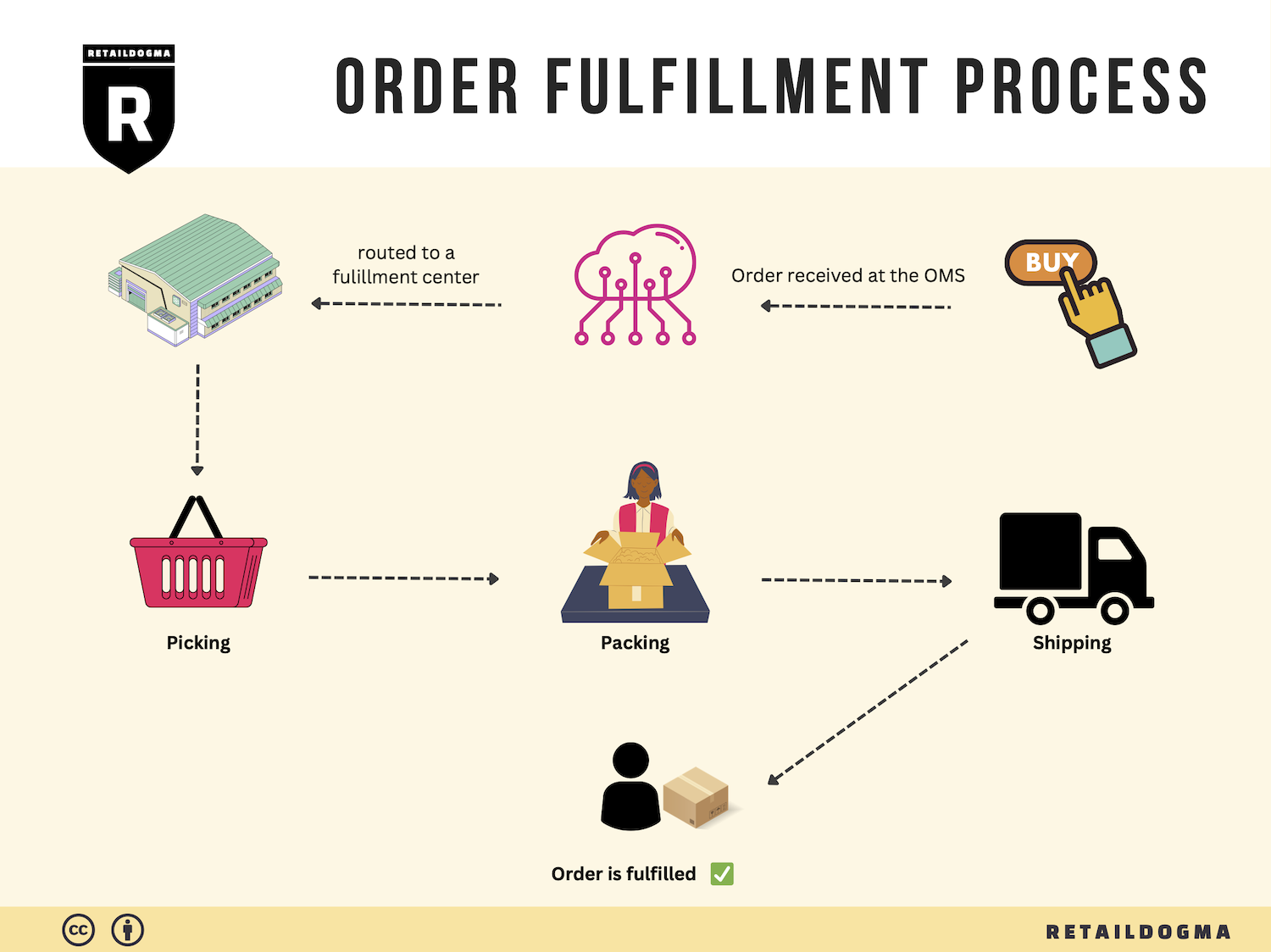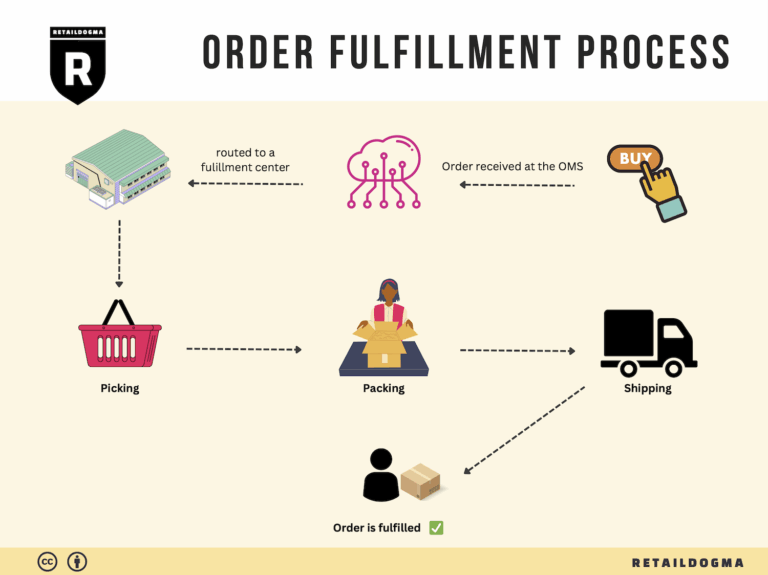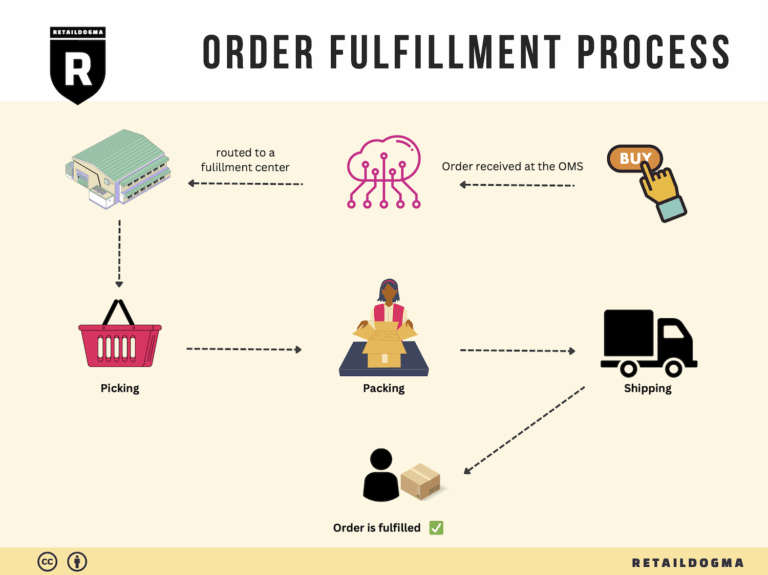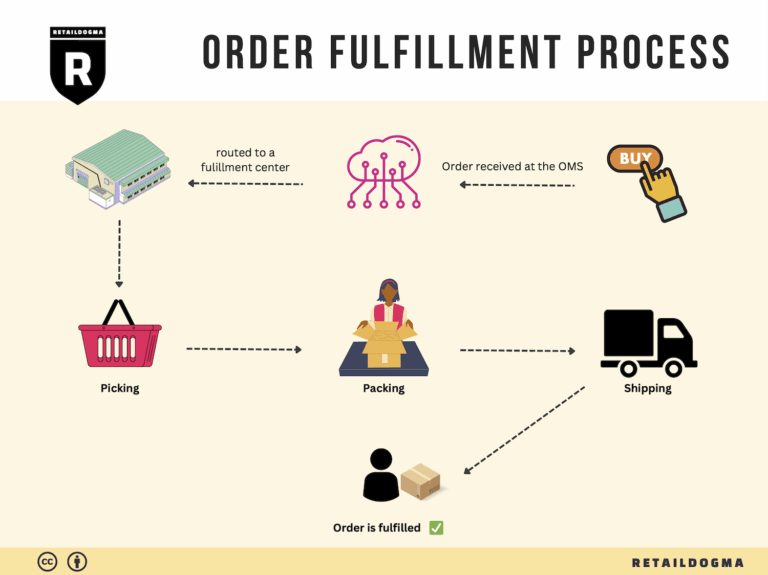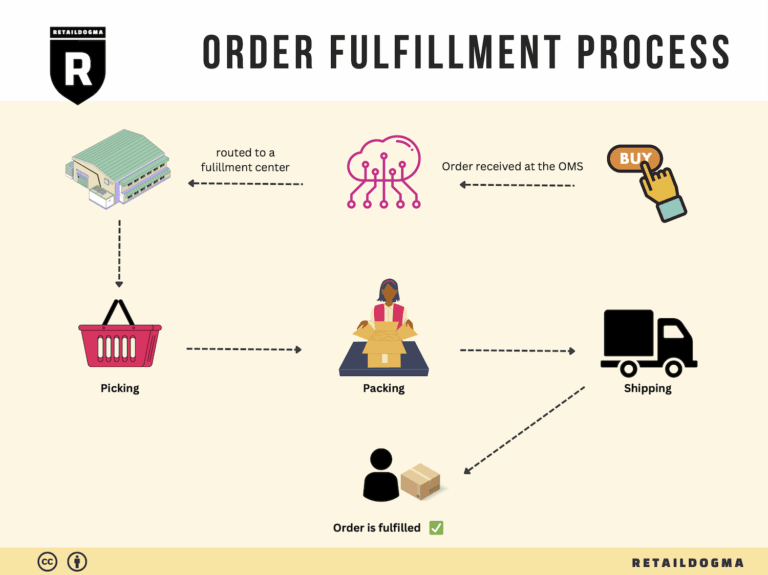Ecommerce Fulfillment Services: The Ultimate Guide (2025)
What is E-commerce Fulfillment? An Introduction for Growing Businesses
The Challenge of Order Fulfillment for Growing E-commerce Businesses
As an e-commerce business owner, you may find yourself overwhelmed with the complexities of packing and shipping orders. While your focus is on growing your sales and expanding your product offerings, the logistics of getting products into the hands of customers can quickly become a daunting task. Balancing inventory management, order processing, and timely shipping can consume valuable time and resources, diverting your attention from strategic growth initiatives.
Fulfillment is fundamentally the process of getting a product from your warehouse or store to your customer’s doorstep. It encompasses a range of activities, including order processing, picking and packing items, managing inventory, and coordinating shipping. For growing businesses, having an efficient fulfillment strategy is crucial to maintaining customer satisfaction and fostering repeat business.
This guide aims to demystify e-commerce fulfillment by breaking down its essential components. We will explore various fulfillment models, including self-fulfillment, third-party logistics (3PL), and Fulfillment by Amazon (FBA). Each model has its own advantages and challenges, and understanding these will help you choose the right approach based on your business size, product type, and market needs.
Additionally, we will discuss the core services offered by fulfillment partners, such as inventory management, order tracking, and returns processing. Knowing what services are available allows you to tailor your logistics strategy to meet customer expectations while managing costs effectively.
Choosing the right fulfillment partner can be a game-changer for your business. We will provide practical guidance on how to evaluate potential partners, what questions to ask, and how to assess their capabilities to ensure they align with your business goals.
Pricing is another critical aspect of fulfillment that can impact your bottom line. We’ll outline the various cost structures associated with different fulfillment models and provide tips on how to optimize your logistics expenses.
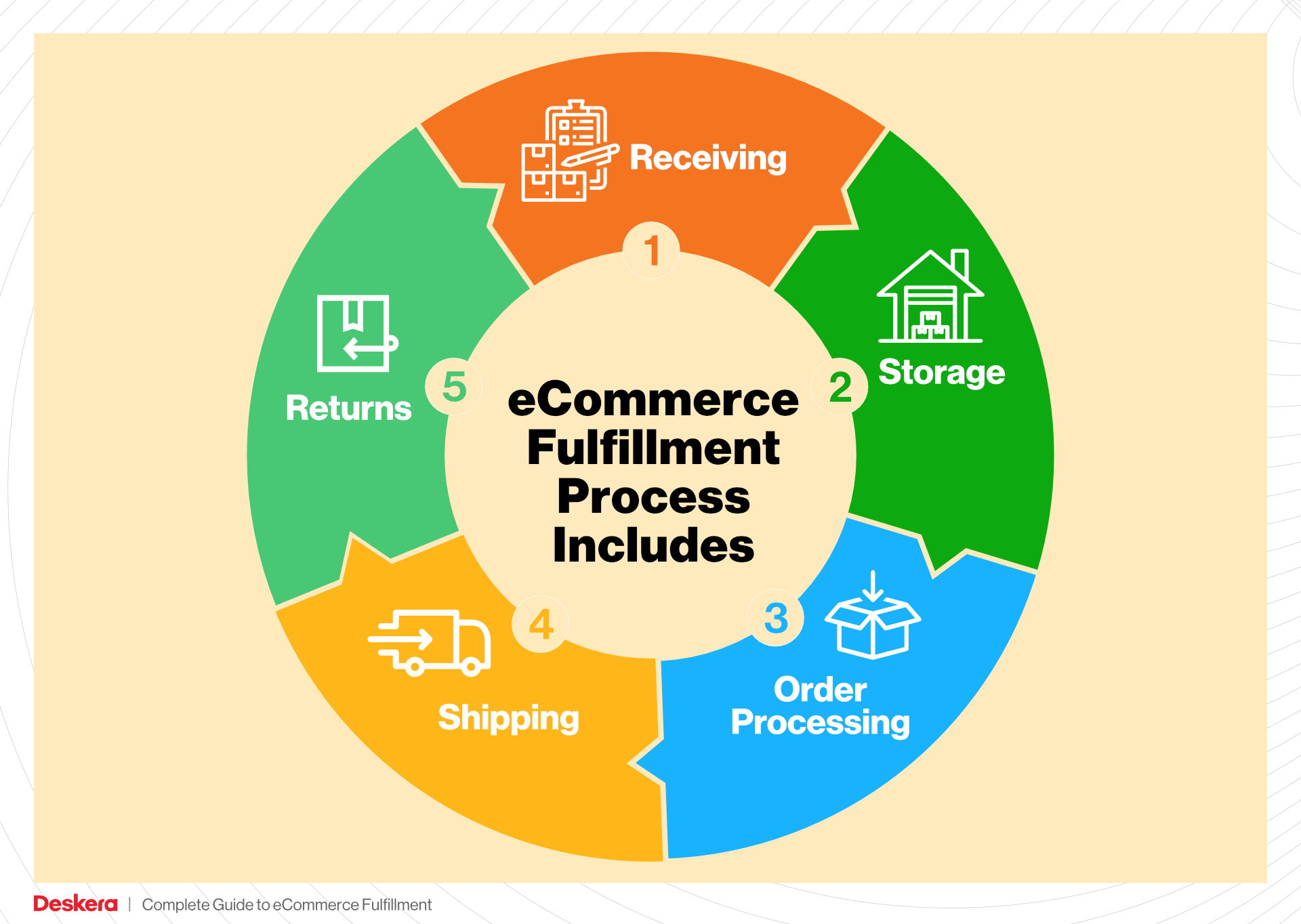
Ultimately, this guide’s goal is to empower e-commerce businesses to make informed and strategic decisions regarding their logistics. By understanding the fulfillment landscape, you can streamline operations, enhance customer satisfaction, and position your business for sustainable growth.
What You’ll Learn In This Guide
- What is E-commerce Fulfillment? An Introduction for Growing Businesses
- The Order Fulfillment Process: From ‘Buy’ Button to Customer’s Door
- Comparing Fulfillment Models: In-House vs. 3PL vs. Dropshipping
- A Deep Dive into Amazon FBA: Pros, Cons, and Who It’s For
- Core Services Offered by Fulfillment Centers
- How to Choose a Fulfillment Partner: A 6-Point Checklist
- Understanding Fulfillment Pricing: A Breakdown of Common Fees
- Frequently Asked Questions (FAQs) about Fulfillment
- Conclusion: Is Outsourcing Fulfillment the Right Move for Your Business?
- Important Disclaimer
The Order Fulfillment Process: From ‘Buy’ Button to Customer’s Door
1. Receiving Inventory
The order fulfillment process begins with receiving inventory from suppliers or manufacturers. This step is crucial as it lays the foundation for the entire fulfillment operation. Upon arrival, goods must be inspected for quality and accuracy against purchase orders. This is typically done using Stock Keeping Units (SKUs), which are unique identifiers assigned to each product.
The importance of this step cannot be overstated; accurate receiving ensures that inventory levels are correctly updated in your system, preventing stockouts or overstock situations. Additionally, a thorough inspection helps identify damaged goods early, allowing for timely returns or replacements. Efficient inventory management starts here, as discrepancies can lead to issues further down the line, including delayed shipments and unhappy customers.
2. Warehouse Storage
Once inventory has been received and verified, the next step involves warehouse storage. Products are organized in a manner that optimizes space and accessibility. This is often guided by a warehouse management system (WMS) that tracks the location of each SKU, facilitating easy retrieval later on.
Proper storage is critical for operational efficiency. It reduces the time spent searching for products during order picking and minimizes the risk of inventory loss or damage. Utilizing techniques like ABC analysis—where items are categorized based on their sales volume—can help prioritize storage locations for high-demand products. This strategic organization enhances overall productivity, making it easier to scale operations as order volumes increase.
3. Order Picking
The order picking stage involves selecting the correct items from storage to fulfill customer orders. This process is guided by pick lists, which detail the products and quantities needed for each order. There are various picking methods, including single order picking, batch picking, and zone picking, each suitable for different business models and order volumes.
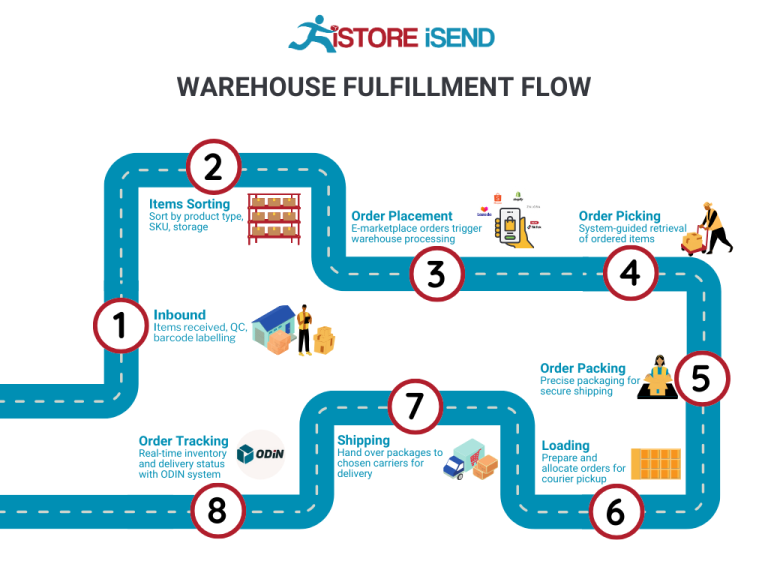
Effective order picking is vital for maintaining customer satisfaction. Errors during this stage can lead to incorrect shipments, resulting in returns and unhappy customers. Utilizing technology, such as barcode scanners or mobile devices, can significantly enhance picking accuracy and speed. By ensuring that the right products are picked efficiently, businesses can meet customer expectations for prompt and accurate deliveries.
4. Order Packing
After picking, the next step is order packing. This involves securely packaging the selected items for shipping. Proper packing not only protects the products during transit but also contributes to a positive unboxing experience for customers. Key considerations during this phase include using appropriate packing materials and ensuring that items are packed according to shipping requirements, which can vary based on the carrier.
The importance of packing cannot be overlooked; a well-packed order reduces the likelihood of damage during shipping, which can lead to costly returns and replacements. Additionally, incorporating branded packaging can enhance brand perception and customer loyalty. Implementing packing slips that summarize the order details also helps customers verify their purchases, further improving the overall experience.
5. Shipping & Delivery
The final step in the fulfillment process is shipping and delivery. Once orders are packed, they are labeled and handed over to shipping carriers. This stage involves choosing the right shipping methods based on cost, speed, and destination, which can significantly impact customer satisfaction. Utilizing shipping software can streamline this process by automatically selecting the best carrier options based on predefined criteria.
Timely and accurate shipping is critical for maintaining a competitive edge in e-commerce. With consumers increasingly expecting fast delivery times, businesses must optimize their shipping strategies to meet these demands. Moreover, providing customers with tracking information enhances transparency and allows them to monitor their orders in real time, fostering trust and satisfaction.
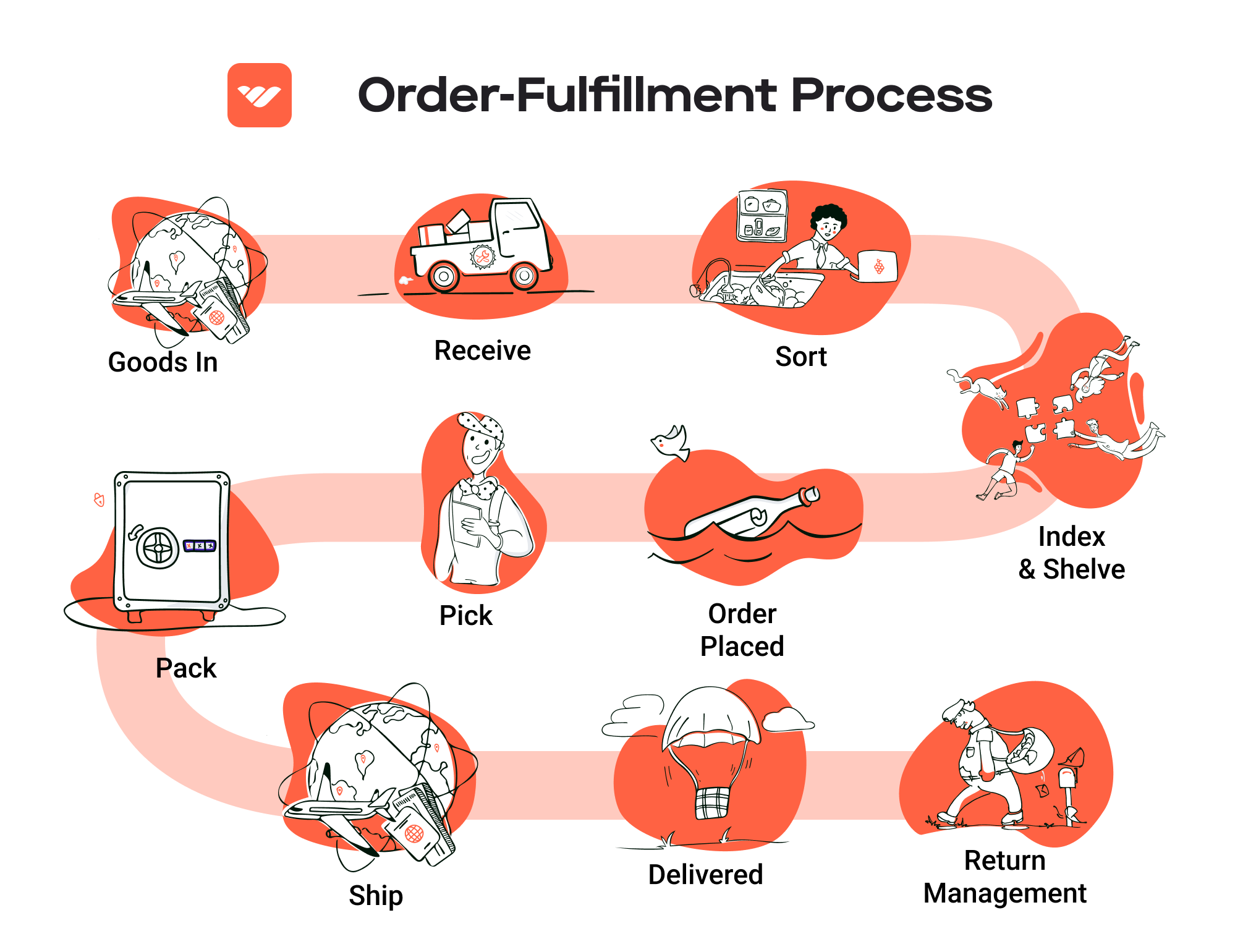
In conclusion, understanding and optimizing each step of the order fulfillment process is essential for e-commerce success. By focusing on efficient inventory management, strategic storage, accurate picking, careful packing, and reliable shipping, businesses can scale operations effectively and enhance customer satisfaction.
Comparing Fulfillment Models: In-House vs. 3PL vs. Dropshipping
Fulfillment Model Comparison
| Model | Who Handles Inventory | Best For (Business Stage) | Key Advantage | Key Disadvantage |
|---|---|---|---|---|
| In-House Fulfillment | The business itself | Startups and small businesses | Full control over inventory and fulfillment | Labor-intensive and requires significant resources |
| Third-Party Logistics (3PL) | Fulfillment partners | Growing businesses | Scalable and cost-effective | Less control over fulfillment processes |
| Dropshipping | Suppliers or manufacturers | New entrants and niche markets | Low upfront investment and risk | Reduced control over shipping and quality |
In-House Fulfillment
In-house fulfillment refers to a model where the e-commerce business manages all aspects of order processing, including inventory management, packing, and shipping, from its own facilities. This model is often favored by startups and small businesses that have unique product offerings or want to maintain complete control over their customer experience. The key advantage of in-house fulfillment is that it allows businesses to oversee every step of the order process, ensuring quality control and the ability to provide personalized service. Furthermore, businesses can adapt quickly to changes in demand or customer preferences. However, the disadvantages are significant; it requires substantial resources, including space, staffing, and technology. As order volumes grow, businesses may find it increasingly challenging to manage logistics effectively, leading to potential delays and customer dissatisfaction.
Third-Party Logistics (3PL)
Third-party logistics, or 3PL, is a fulfillment model where businesses outsource their logistics operations to specialized providers. These providers manage inventory storage, order processing, packing, and shipping, allowing businesses to focus on other areas such as marketing and product development. This model is particularly beneficial for growing businesses that experience fluctuating order volumes and need a scalable solution. One of the primary advantages of using a 3PL is cost-effectiveness; these providers often have established relationships with carriers, enabling them to negotiate better shipping rates and optimize delivery times. Additionally, 3PLs can offer advanced technology for inventory management and order tracking. However, the key disadvantage is the loss of control over the fulfillment process. Businesses must ensure that their 3PL partner aligns with their brand values and maintains the level of service expected by their customers. Miscommunication or errors can lead to dissatisfied customers, impacting overall brand reputation.
Dropshipping
Dropshipping is a fulfillment model where retailers sell products without holding any inventory. Instead, when a customer places an order, the retailer forwards the order details to a supplier or manufacturer, who then ships the product directly to the customer. This model is often favored by new entrants in the e-commerce market, as it requires minimal upfront investment and eliminates the risks associated with unsold inventory. The key advantage of dropshipping is that it allows entrepreneurs to test new products and markets with low financial risk. Additionally, it enables them to focus on marketing and customer acquisition rather than logistics. However, dropshipping also comes with significant drawbacks. Retailers have limited control over product quality, shipping times, and customer service, which can lead to inconsistencies in the customer experience. Furthermore, as competition in dropshipping increases, profit margins can become razor-thin, making it essential for businesses to differentiate themselves through branding and customer engagement.
In conclusion, choosing the right fulfillment model is crucial for the success of an e-commerce business. Each model—In-House Fulfillment, 3PL, and Dropshipping—comes with its own set of advantages and disadvantages that must be carefully weighed against the business’s specific needs, resources, and growth trajectory. As businesses scale, they may find that transitioning between these models is necessary to maintain efficiency and meet customer expectations effectively. Understanding the nuances of each model will enable e-commerce entrepreneurs to make informed decisions that align with their operational capabilities and long-term goals.
A Deep Dive into Amazon FBA: Pros, Cons, and Who It’s For
What is Fulfillment by Amazon (FBA)?
Fulfillment by Amazon (FBA) is a service offered by Amazon that allows sellers to store their products in Amazon’s fulfillment centers. Amazon takes care of storage, packaging, shipping, and customer service on behalf of the sellers. This means that when a customer orders a product, Amazon handles the entire fulfillment process, from picking the product off the shelf to delivering it to the customer’s doorstep. Sellers who use FBA can also benefit from Amazon’s extensive logistics network, which can significantly enhance their shipping capabilities.
To utilize FBA, sellers first need to create an Amazon Seller account and enroll in the FBA program. They then send their inventory to Amazon’s warehouses, where it is stored until orders are placed. When an order is received, Amazon picks, packs, and ships the product directly to the customer. This service not only simplifies logistics but also allows sellers to leverage Amazon’s trusted brand, potentially increasing sales.
How Does FBA Work?
-
Setup and Inventory Management: Sellers set up their FBA account through their Amazon Seller Central. They create product listings and indicate which products they want to fulfill through FBA. Sellers are responsible for preparing their products according to Amazon’s packaging guidelines before sending them to Amazon fulfillment centers.
-
Storage: Once the products arrive at Amazon’s warehouses, they are stored until sold. Amazon uses sophisticated inventory management systems to track products and optimize storage space.
-
Order Fulfillment: When a customer places an order, Amazon’s system automatically detects the product and initiates the fulfillment process. The product is picked from the shelf, packed, and shipped, often with options for fast delivery, including Amazon Prime two-day shipping.
-
Customer Service and Returns: Amazon manages all customer service inquiries related to FBA orders, including handling returns and refunds. This allows sellers to focus more on their business rather than customer service issues.
Pros of Using FBA
1. Prime Eligibility
One of the most significant advantages of using FBA is the ability to offer products with Amazon Prime eligibility. This feature attracts a vast customer base who are Prime members and expect fast, free shipping. Products fulfilled by Amazon are often prioritized in search results, leading to increased visibility and sales potential.
2. Customer Trust
Amazon is synonymous with reliability and customer satisfaction. By using FBA, sellers can leverage Amazon’s reputation, which can enhance consumer trust in their products. The assurance of Amazon’s customer service and return handling further boosts buyer confidence.
3. Multi-Channel Fulfillment
FBA isn’t limited to sales made on Amazon. Sellers can utilize FBA to fulfill orders from their own websites and other sales channels. This allows for a streamlined fulfillment process and the ability to offer excellent shipping options across various platforms.
4. Scalability
FBA provides an efficient way to scale operations. As demand for products increases, sellers can easily send more inventory to Amazon without the need for additional warehousing or logistics infrastructure.
5. Automated Logistics
Amazon takes care of all logistics, which means sellers can focus on other aspects of their business, such as marketing and product development. FBA simplifies shipping and inventory management, reducing the operational burden on sellers.
Cons of Using FBA
1. High Fees
While FBA offers many conveniences, it comes at a cost. Amazon charges various fees, including storage fees for keeping products in their warehouses and fulfillment fees for picking, packing, and shipping items. For sellers with low margins, these fees can significantly cut into profits.
2. Strict Inventory Rules
Amazon has stringent inventory management policies. Sellers must adhere to guidelines regarding product preparation, labeling, and packaging. Failure to comply can result in additional fees or even account suspensions.
3. Commingling Risks
With FBA, products from multiple sellers can be stored together in Amazon’s warehouses. This commingling can pose risks, such as receiving returns of items that are not your own. While Amazon has policies to manage this, it can still lead to complications for sellers, particularly those with unique or branded products.
4. Loss of Control
When using FBA, sellers relinquish a degree of control over their inventory and shipping processes. This can lead to issues such as stockouts or delays, especially if Amazon’s fulfillment centers experience high demand or logistical challenges.
5. Dependency on Amazon
Relying on FBA can create a dependency on Amazon’s platform. Changes in Amazon’s policies, fee structures, or algorithms can significantly impact a seller’s business, making it essential to maintain diversified sales channels.
Who is FBA Best For?
Fulfillment by Amazon is particularly well-suited for:
-
New Sellers: Those just starting out may find FBA an excellent way to access Amazon’s massive customer base without needing extensive logistics knowledge or infrastructure.
-
High-Volume Sellers: Businesses with a large volume of sales can benefit from the efficiencies of FBA, particularly those who sell products that are eligible for Prime shipping.
-
E-commerce Entrepreneurs: Sellers looking to scale their business quickly and efficiently can leverage FBA’s logistics capabilities while focusing on growth strategies.
-
Businesses with Limited Fulfillment Resources: Companies that lack the infrastructure to manage their own warehousing and shipping can find FBA an effective solution to streamline their operations.
In conclusion, while Fulfillment by Amazon presents a powerful opportunity for e-commerce sellers to enhance their logistics and reach, it is crucial for businesses to weigh the pros and cons carefully. Understanding how FBA aligns with their operational goals and customer expectations will help sellers make informed decisions about incorporating this fulfillment model into their business strategy.
Core Services Offered by Fulfillment Centers
Inventory Management & Warehousing
Inventory management and warehousing are foundational services provided by fulfillment centers. This process encompasses the systematic tracking of inventory levels, orders, sales, and deliveries. Fulfillment centers utilize advanced inventory management systems to ensure that stock is accurately monitored and that businesses have real-time visibility into their inventory status.
The benefits of effective inventory management are manifold. First, it minimizes the risk of stockouts and overstock situations, both of which can have significant financial implications. Stockouts can lead to lost sales and diminished customer satisfaction, while overstocking increases holding costs and may result in unsold inventory. With optimized inventory management, e-commerce businesses can maintain the right balance of stock, ensuring they meet customer demand without incurring unnecessary costs.
Additionally, fulfillment centers often store inventory in strategically located warehouses, allowing businesses to reduce shipping times and costs. By positioning inventory closer to key markets, businesses can enhance their delivery speed, thus improving customer satisfaction and retention.
Pick and Pack Services
Pick and pack services are essential components of the order fulfillment process. This service involves selecting the correct items from inventory (picking) and packaging them appropriately for shipment (packing). Fulfillment centers employ trained staff and automated systems to handle these tasks efficiently, ensuring that orders are processed quickly and accurately.
The benefits of pick and pack services extend beyond mere speed. Accuracy in order fulfillment is critical; mistakes can lead to returns, customer dissatisfaction, and ultimately, a tarnished brand reputation. Fulfillment centers implement quality control measures to minimize errors, ensuring that the right products reach customers in pristine condition.
Moreover, outsourcing pick and pack services allows e-commerce businesses to focus on core activities such as marketing and product development. By entrusting these logistics functions to experts, businesses can scale operations without the need for significant investments in infrastructure or labor.
Kitting and Assembly
Kitting and assembly services involve combining multiple products into a single package or preparing items for sale. This can include assembling components for a product, creating gift sets, or bundling items for promotional offers. Fulfillment centers can manage these processes, enabling businesses to offer more complex products without the logistical burden.
The primary benefit of kitting and assembly services is the enhancement of product offerings. By providing bundled products or customized kits, businesses can increase their average order value and appeal to a broader customer base. Additionally, these services can streamline the order fulfillment process, as customers receive a single, ready-to-use package rather than multiple separate items.
Kitting also improves inventory management, as fulfillment centers can monitor the components of each kit, ensuring that all necessary items are in stock and ready for assembly. This proactive approach reduces the risk of delays and enhances customer satisfaction.
Returns Management (Reverse Logistics)
Returns management, also known as reverse logistics, is a critical service that addresses the handling of returned products. Fulfillment centers streamline the returns process, managing the logistics of receiving, inspecting, restocking, or disposing of returned items. This service is essential in today’s e-commerce landscape, where return rates can be as high as 30% for certain categories of products.
The benefits of efficient returns management are substantial. First, it enhances customer satisfaction by providing a hassle-free return experience. A well-managed return process can convert unhappy customers into loyal ones, as they appreciate the ease of returning products. Furthermore, fulfillment centers can analyze return data to identify trends and reasons for returns, enabling businesses to address underlying issues, such as product quality or inaccurate descriptions.
Moreover, effective returns management helps businesses recover value from returned items. Fulfillment centers can inspect and refurbish returned products, allowing them to be resold rather than written off as losses. This not only mitigates financial impacts but also contributes to sustainable business practices by reducing waste.
In conclusion, leveraging the core services offered by fulfillment centers—inventory management and warehousing, pick and pack services, kitting and assembly, and returns management—can significantly enhance the operational efficiency of e-commerce businesses. By outsourcing these critical functions, businesses can focus on growth and customer engagement while ensuring that logistics are handled by experts in the field.
How to Choose a Fulfillment Partner: A 6-Point Checklist
Location & Warehouse Network
Choosing a fulfillment partner with strategically located warehouses is crucial for minimizing shipping times and costs. The closer your fulfillment centers are to your customer base, the faster and more affordably you can deliver orders.
Why It’s Important:
Fast shipping enhances customer satisfaction and can lead to repeat business. Additionally, being close to major transportation hubs can reduce shipping costs and improve logistics efficiency.
Questions to Ask:
– Where are your warehouses located, and how do they align with my target market?
– What is your average shipping time from each warehouse to key regions?
– Do you have a network of fulfillment centers that can accommodate seasonal spikes in demand?
Technology & Integrations
A robust technology platform is vital for seamless order processing, inventory management, and real-time tracking. Your fulfillment partner should offer integrations with your existing e-commerce platforms, like Shopify, to streamline operations.
Why It’s Important:
Efficient technology can automate processes, reduce errors, and provide valuable insights into inventory and order status, all of which are essential for scaling your business.
Questions to Ask:
– What software do you use for inventory management and order processing?
– Can your system integrate with my e-commerce platform, and what APIs do you provide?
– Do you offer real-time tracking for orders, and how is this information communicated to my customers?
Specializations (e.g., Cold Storage, Oversized Items)
Not all fulfillment partners are equipped to handle every type of product. If your business involves specialized items—such as perishable goods requiring cold storage or oversized items—ensure your partner has the necessary facilities and expertise.
Why It’s Important:
Specialized storage and handling can prevent product damage and ensure compliance with regulations, thereby protecting your brand and reducing returns.
Questions to Ask:
– Do you have specialized storage capabilities (e.g., cold storage, hazardous materials)?
– How do you handle unique packaging requirements for oversized or fragile items?
– What certifications or compliance measures do you have in place for specialized products?
Scalability & Capacity
As your business grows, your fulfillment partner should be able to scale operations to meet increasing demand. This includes having the capacity to manage larger volumes of orders and the flexibility to adapt to your business’s changing needs.
Why It’s Important:
A partner that can easily scale with you can save you time and money, preventing the need for frequent changes in logistics providers as your business evolves.
Questions to Ask:
– What is your current capacity, and how easily can you scale up during peak seasons?
– Have you managed rapid growth for other clients? Can you provide examples?
– What strategies do you have in place to handle fluctuations in order volume?
Pricing and Contracts
Understanding the pricing structure and contract terms is essential to avoid unexpected costs. Look for transparency in pricing, including storage fees, shipping costs, and any additional charges that may arise.
Why It’s Important:
Clear pricing helps you budget effectively and ensures that you can maintain profit margins as your business grows. Long-term contracts should also be evaluated for flexibility.
Questions to Ask:
– Can you provide a detailed breakdown of your pricing model?
– Are there any hidden fees, such as for returns or special handling?
– What are the terms of the contract, and is there flexibility for scaling up or down?
Customer Support & Reviews
Reliable customer support is a cornerstone of a successful partnership. Your fulfillment partner should provide accessible and responsive customer service to address any issues quickly.
Why It’s Important:
Effective customer support can mitigate problems before they affect your customers, ensuring smooth operations and maintaining your business’s reputation.
Questions to Ask:
– What kind of customer support do you offer (e.g., phone, email, chat)?
– What are your average response times for customer inquiries?
– Can you provide references or reviews from other clients, particularly those in my industry?
Conclusion
Choosing the right fulfillment partner is a critical decision that can significantly impact your e-commerce business’s efficiency and growth. By using this checklist, you can systematically evaluate potential partners, ensuring they align with your operational needs and long-term goals. Take the time to assess each point thoroughly, as the right partner can be a valuable asset in your journey towards scaling your business successfully.
Understanding Fulfillment Pricing: A Breakdown of Common Fees
Initial Setup Fees
Initial setup fees are the costs associated with onboarding a new fulfillment provider. These fees can vary significantly based on the complexity of your inventory and the chosen fulfillment partner. Typically, these fees cover the following:
- Account Setup: This includes creating your account and integrating your e-commerce platform (like Shopify) with the fulfillment provider’s system.
- Inventory Configuration: If your products require unique SKU management or have specific packaging needs, additional fees may apply for configuring these details in the system.
- Training: Some providers may charge for training sessions to familiarize your team with their processes and technology.
To calculate initial setup fees, inquire with potential partners about their pricing structure and any specific requirements related to your business model.
Receiving Fees
Receiving fees are charged when your inventory arrives at the fulfillment center. These fees cover the labor and resources needed to unload, inspect, and store your products. Factors that influence receiving fees include:
- Volume of Inventory: Larger shipments may incur lower per-unit receiving fees due to economies of scale.
- Condition of Goods: If items require extra handling due to damage or lack of proper labeling, additional fees may apply.
- Special Handling Needs: Certain products may need special handling or storage conditions, which can also increase receiving fees.
Receiving fees are typically calculated on a per-pallet or per-carton basis. It’s essential to clarify these fees upfront to avoid surprises when your inventory arrives.
Storage Fees (per pallet/bin)
Storage fees are charged for the space your inventory occupies in the fulfillment center. These fees are often calculated on a monthly basis and can vary based on:
- Type of Storage: Rates may differ for standard storage versus climate-controlled environments, especially for perishable or sensitive items.
- Volume of Inventory: The more space your products take up, the higher your storage fees will be. Providers often charge by the pallet, bin, or cubic foot.
- Duration of Storage: Long-term storage fees may apply if your inventory remains in the warehouse beyond a specified period (usually 30 days). This is especially pertinent for businesses with slow-moving inventory.
To manage storage costs effectively, consider negotiating terms with your fulfillment provider regarding minimum inventory levels and turnover rates.
Pick & Pack Fees (per item/order)
Pick and pack fees are charged for the process of retrieving items from storage and preparing them for shipment. This fee structure can include:
- Pick Fees: The cost to pick items from shelves; this is often charged per item or per order.
- Pack Fees: The cost associated with packaging the products for shipping, which may vary based on the type of packaging used.
Factors affecting pick and pack fees include:
- Order Complexity: More complex orders with multiple SKUs may incur higher fees due to the increased labor involved.
- Packaging Requirements: If your products require special packaging (e.g., fragile items), additional fees may apply.
Understanding how your fulfillment partner structures their pick and pack fees is crucial for accurately forecasting your fulfillment costs.
Shipping Fees
Shipping fees are the costs incurred to transport packages from the fulfillment center to your customers. These fees can be influenced by several factors:
- Shipping Method: Choices between standard, expedited, or overnight shipping will significantly affect costs. Providers may offer different rates based on the carrier and service level.
- Weight and Dimensions: Heavier or larger packages will generally incur higher shipping fees. Most providers use dimensional weight pricing, which considers both weight and size.
- Destination: Shipping costs can vary based on the distance to the delivery location and whether it’s domestic or international.
Shipping fees are usually calculated per package and can be affected by negotiated rates with carriers. It’s beneficial to ask your fulfillment partner about any available discounts based on your shipping volume.
Tips for Getting an Accurate Quote
To obtain an accurate quote for fulfillment services, consider the following tips:
- Provide Detailed Information: Be clear about your product types, volumes, and any specific requirements (like temperature control or special packaging).
- Ask for a Breakdown: Request itemized quotes that outline all potential fees, including setup, receiving, storage, pick & pack, and shipping.
- Negotiate Rates: Don’t hesitate to negotiate terms, especially if you have a high shipping volume or long-term partnership potential.
- Compare Multiple Providers: Obtain quotes from several fulfillment companies to understand the market rates and find a partner that fits your budget and needs.
- Review Contract Terms: Ensure you understand the contract terms, including any hidden fees, minimum order requirements, and long-term commitments.
By following these guidelines, you can make informed decisions about your fulfillment pricing and choose a provider that aligns with your business goals.
Frequently Asked Questions (FAQs) about Fulfillment
1. What is ecommerce fulfillment?
Ecommerce fulfillment is the comprehensive process of receiving, processing, and delivering orders to customers who purchase products online. It encompasses inventory management, order picking, packing, shipping, and handling returns, ensuring that products reach customers efficiently and accurately.
2. How do I fulfill orders on Shopify?
You can fulfill orders on Shopify by either managing the fulfillment process in-house or by utilizing a third-party fulfillment service (3PL). For in-house fulfillment, you will handle inventory management and shipping directly from your location. Alternatively, you can integrate with a 3PL provider, which will manage storage, packaging, and shipping, allowing you to focus on other aspects of your business.
3. What is a fulfillment center, and how does it differ from a warehouse?
A fulfillment center is a specialized facility designed specifically for the purpose of fulfilling online orders. It includes advanced systems for inventory management and order processing, enabling faster shipping. In contrast, a warehouse primarily serves as a storage space for goods and may not have the same level of operational efficiency or technology for order fulfillment.
4. What is a 3PL, and why should I consider using one?
A 3PL, or third-party logistics provider, is a service that manages a company’s logistics and fulfillment operations. By outsourcing to a 3PL, you can benefit from their expertise in inventory management, order processing, and shipping logistics, allowing you to scale your business without the overhead costs of managing these operations in-house.
5. How much do fulfillment services cost?
The cost of fulfillment services can vary widely based on factors such as order volume, the size and weight of products, shipping methods, and additional services like returns processing. Generally, fulfillment costs can range from $2 to $5 per order, plus storage fees that can be charged monthly or per cubic foot. It’s essential to evaluate different fulfillment partners to find one that aligns with your business needs and budget.
6. What are the benefits of using Shopify Fulfillment Network?
The Shopify Fulfillment Network (SFN) connects your Shopify store to trusted logistics partners, streamlining order management and enhancing delivery speed. Benefits include real-time inventory tracking, access to multiple fulfillment centers for reduced shipping times, and the ability to manage all aspects of fulfillment directly through your Shopify dashboard.
7. How can I improve my order fulfillment speed?
To improve order fulfillment speed, consider optimizing inventory placement by utilizing multiple fulfillment centers closer to your customer base. Automating order processing through integrated software solutions and establishing clear protocols for picking and packing can also enhance efficiency. Additionally, maintaining adequate inventory levels and leveraging expedited shipping options can further reduce delivery times.
8. What should I look for in a fulfillment partner?
When selecting a fulfillment partner, consider factors such as their experience and reputation in the industry, technology capabilities, shipping options, and pricing structure. It’s also important to evaluate their customer service and support, the flexibility of their services to accommodate growth, and their ability to handle returns efficiently.
9. Can I manage returns through my fulfillment provider?
Yes, many fulfillment providers offer returns management services. This includes processing returned items, restocking inventory, and handling customer communications related to returns. Utilizing your fulfillment partner for returns can streamline the process and enhance customer satisfaction by ensuring a hassle-free experience.
10. What is dropshipping, and how does it differ from traditional fulfillment?
Dropshipping is a fulfillment method where the retailer does not keep products in stock but instead forwards customer orders to a supplier, who ships the products directly to the customer. Unlike traditional fulfillment, where businesses manage inventory and shipping, dropshipping allows for lower upfront costs and reduced inventory risk, but it can lead to longer delivery times and less control over the customer experience.
Conclusion: Is Outsourcing Fulfillment the Right Move for Your Business?
Evaluating the Benefits of Outsourcing Fulfillment
Outsourcing your fulfillment process can be a game-changer for your e-commerce business. One of the most significant advantages is time savings. By leveraging a fulfillment service, you can redirect your focus from the intricacies of packing and shipping to core business activities such as marketing, product development, and customer engagement. This not only enhances productivity but also allows you to respond more effectively to market demands.
Scalability is another critical benefit. As your business grows, so do your order volumes. Fulfillment partners are equipped to handle fluctuations in demand, providing the flexibility you need to expand without the burden of managing increased logistics in-house. This capability ensures that you can maintain a high level of service even during peak periods, a crucial factor for customer satisfaction and retention.
Moreover, partnering with a fulfillment service brings expertise to the table. These providers often have established networks and logistics systems that can optimize shipping times and reduce costs. Their knowledge of best practices can enhance your operational efficiency, providing insights that you may not have access to as a smaller operation.
However, choosing the right fulfillment partner is paramount for sustainable growth. Evaluate potential partners based on their track record, technology integration, and customer service capabilities. A well-aligned partner can significantly amplify your business potential.
Call to Action
As you contemplate your fulfillment strategy, take a moment to audit your current shipping process. Are you experiencing delays, high costs, or customer complaints? If so, it may be time to consider a fulfillment partner. Start by mapping out your logistics needs and exploring providers that align with your business goals. Transitioning to a fulfillment service could be the strategic move that propels your e-commerce business to new heights.
Important Disclaimer
⚠️ Important Disclaimer
The information in this guide is for educational purposes. Fulfillment services, pricing, and platform features change frequently. Always conduct your own due diligence and consult with providers directly before making business decisions.
